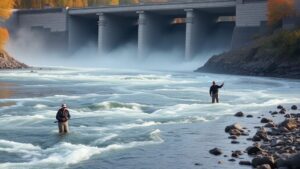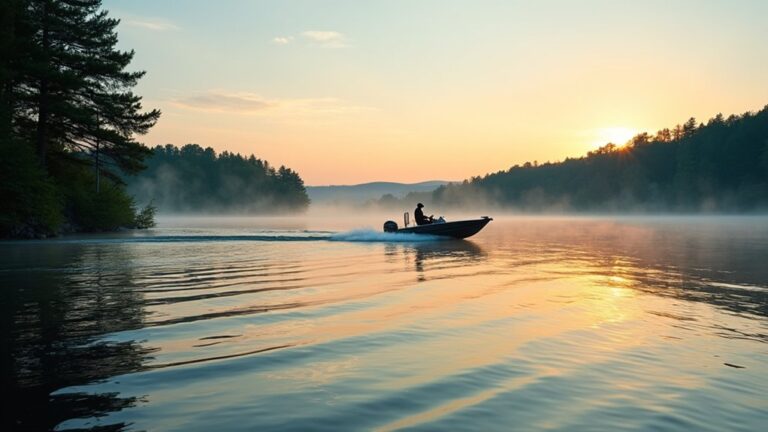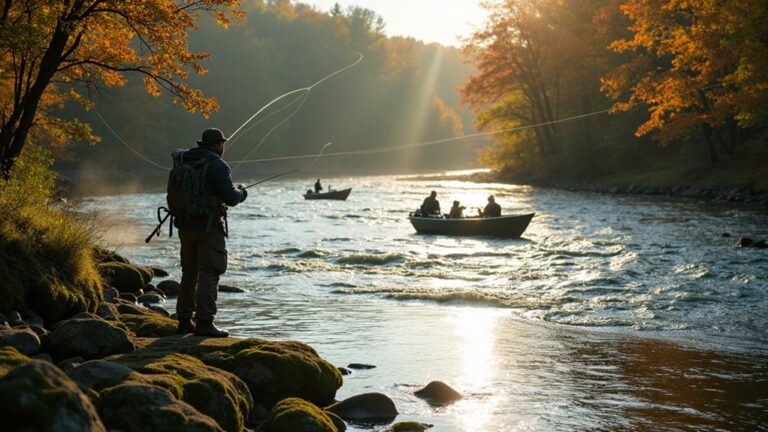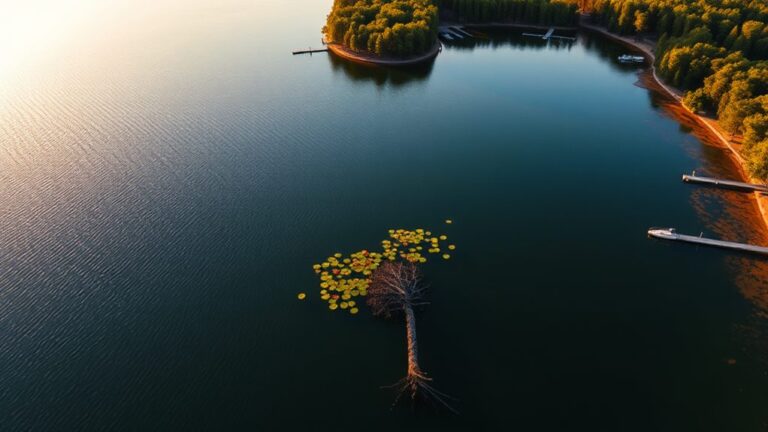The most productive fishing spots below power dams are found where turbulent water creates natural feeding zones and gathering points for fish. You'll want to focus on discharge gate areas, current seams, and eddy pools where baitfish congregate, especially during peak feeding times at dawn and dusk. For best results, fish when flow rates are between 300-600 ft/sec, and keep safety in mind by maintaining distance from discharge gates. Channel catfish, white bass, and crappie are common catches, particularly during spring spawning season. While basic spinning gear works well, your success will multiply once you understand how dam operations influence fish behavior.
Safety Considerations When Dam Fishing
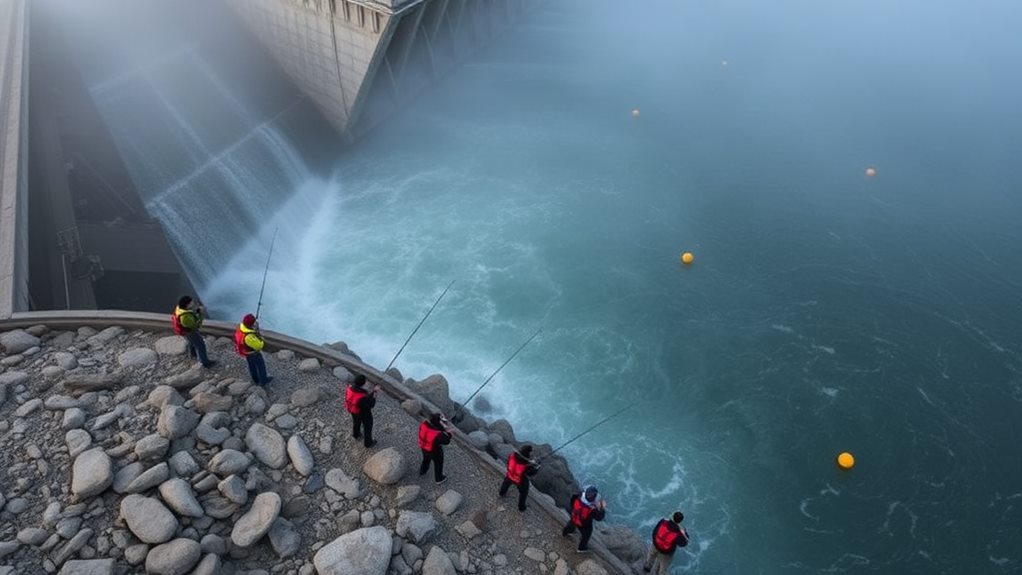
Near hydroelectric dams, fishing can be both rewarding and dangerous. Before casting your line, you'll need to understand crucial safety protocols and regulations that govern dam fishing areas.
First, check the flow rates – anything above 1,000 ft/sec can create hazardous conditions and poor fishing opportunities. It's not worth risking your safety for a catch!
When selecting your access points, make sure you're following local regulations, as different dams have varying rules about when and where you can fish. You'll want to maintain a safe distance from discharge gates and stay aware of any barrier cables that mark dangerous zones.
Keep these vital safety tips in mind:
- Always assess water conditions before approaching
- Watch for slippery terrain near water's edge
- Stay clear of restricted areas and warning signs
- Monitor changing water levels throughout your visit
Don't forget to scout your location during daylight hours first – this helps you identify potential hazards and safe access routes.
Prime Fishing Spots Below Dams
Below hydroelectric dams, you'll find some of the most productive fishing spots around. The San Jacinto River, for instance, offers incredible opportunities for catching channel cats and other species in oxygen-rich waters that keep fish active and hungry.
You'll often find the best action near discharge gates, where currents create perfect feeding zones for various fish species.
To maximize your success when fishing below dams, focus on these prime locations:
- Discharge gate areas where turbulent water attracts baitfish
- Current seams where fast and slow waters meet, creating natural feeding zones
- Eddy pools that form behind large rocks or structural features
- Deep holes immediately downstream from the main flow
The combination of moving water and abundant oxygen makes these spots particularly attractive to fish.
You'll notice that during turbine operations, the fishing typically gets even better as more baitfish get pulled through the system.
Unlike crowded lakes, dam fishing spots often provide easier access and a more peaceful experience.
With reports of anglers landing 15-20 fish in a single outing, it's clear why these locations have become go-to destinations for serious fishermen.
Essential Gear and Equipment
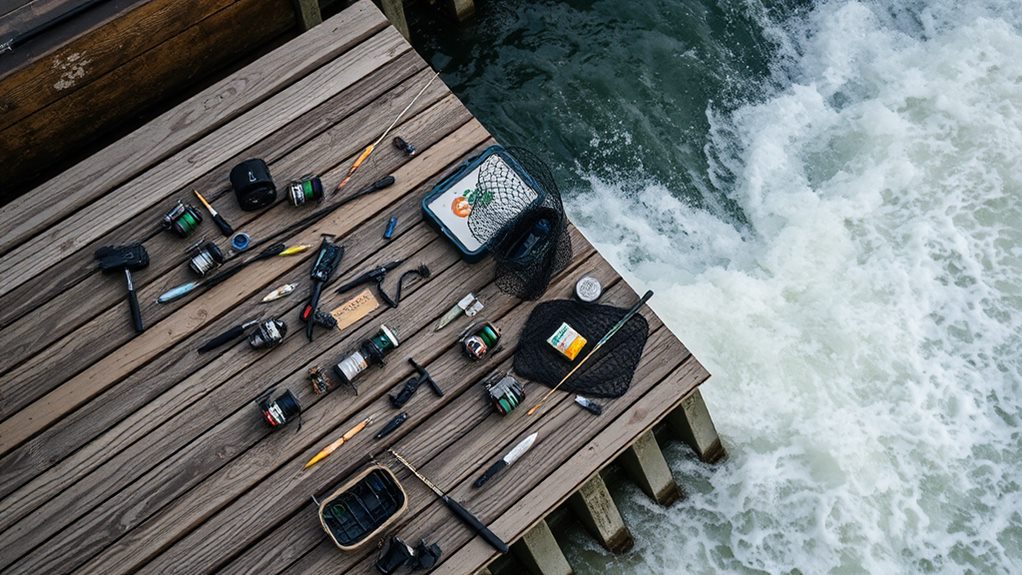
Successful fishing below dams requires the right combination of gear to handle strong currents and larger fish. When you're targeting channel catfish, you'll want to start with a 7ft medium-heavy spinning rod that gives you the perfect balance of strength and flexibility.
Regular inspections of gear help guarantee your equipment performs at its best in challenging dam conditions. Pair this with 20lb fluorocarbon line, which provides excellent sensitivity while standing up to the challenges of river fishing.
For daytime fishing, slip bobber rigs are your best friend, letting you present bait at precise depths where catfish like to hang out. Don't forget to match your sinker size to the current – you'll need enough weight to keep your bait in place without getting snagged on the bottom. A properly weighted rig helps maintain control in those powerful dam currents.
As for bait, you'll want to keep a variety of options in your tackle box. Sonny's Blood Formula and other punch baits are proven catfish attractors that stay on your hook, even in strong currents.
Understanding Water Flow Patterns
The dynamics of water flow patterns make or break your fishing success below power dams. When you're planning your fishing spot, understanding how water moves and affects fish behavior can give you a significant advantage.
You'll find that fish naturally seek areas where they don't have to fight strong currents, allowing them to conserve energy while staying alert for feeding opportunities.
Here are the key patterns you'll want to monitor for the best results:
- Current speed differences – surface water moves faster than bottom water, so fish often stay deep
- Ideal flow rates between 300-600 ft/sec provide the best fishing conditions
- Dam operations create predictable patterns that influence fish movement
- Eddies and seams form natural collection points where fish gather
Pay attention to when the dam's turbines are running, as these operations directly impact water flow patterns and baitfish activity.
You'll notice increased feeding activity during operational periods, making these times prime for catching fish.
Best Times To Fish
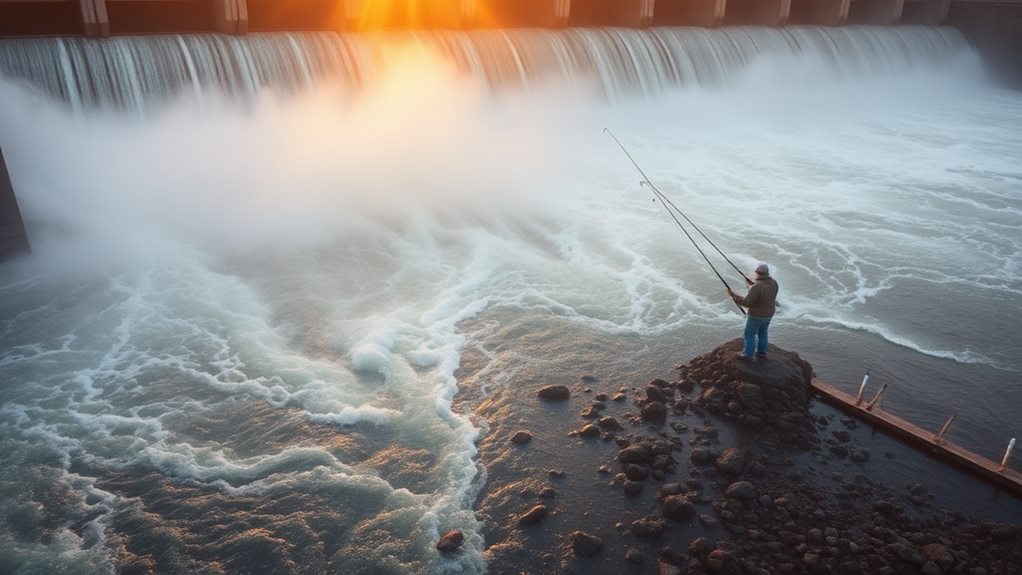
Knowing when to cast your line can dramatically improve your catch rate below power dams. The best times to fish are typically during early morning and late evening hours when fish are most active and feeding. You'll find spring is particularly productive, especially for species like crappie and catfish that are spawning during this season.
| Time of Day | Season | Best Species |
|---|---|---|
| Early Morning | Spring | White Bass |
| Late Evening | Summer | Catfish |
| Dawn/Dusk | Fall | Crappie |
To maximize your success when you fish below a dam, you'll want to pay attention to the dam's operation schedule. When turbines are running and water discharge rates fall between 300-600 ft/sec, fish tend to be more aggressive. During summer months, you might want to adjust your schedule – late evening fishing becomes more productive as water temperatures rise during the day. Keep in mind that dawn offers prime conditions for species like white bass, while dusk can be excellent for catfish. Remember to check the dam's discharge schedule before heading out, as this information can help you plan your fishing trip during ideal water flow conditions.
Top Fish Species Present
Anglers fishing below power dams can target several prime species throughout the year.
You'll find a diverse mix of fish that thrive in these oxygen-rich waters, each with their own unique patterns and behaviors. Using basic fishing gear like a 6.6-inch spincast rod and 10 lb. monofilament line will help you target most species effectively. Understanding which species are present and when they're most active will help you plan your fishing trips more effectively.
- Channel catfish – These bottom-dwellers are year-round residents that love the turbulent waters, and they'll readily strike live bait like shad or bluegill.
- White bass – They're most active during early morning hours, so you'll want to be on the water at dawn for your best chance at success.
- Hybrid bass – Look for them around rip-rap zones, where they frequently patrol for prey.
- Crappie – Spring is your prime time to target these popular gamefish during their spawning season.
You might also encounter redfish, especially during drought conditions, when their numbers can increase dramatically.
In fact, you could potentially catch dozens in a single day when conditions are right. Each species responds differently to seasonal changes, so it's worth learning their patterns to maximize your success.
Local Access Points
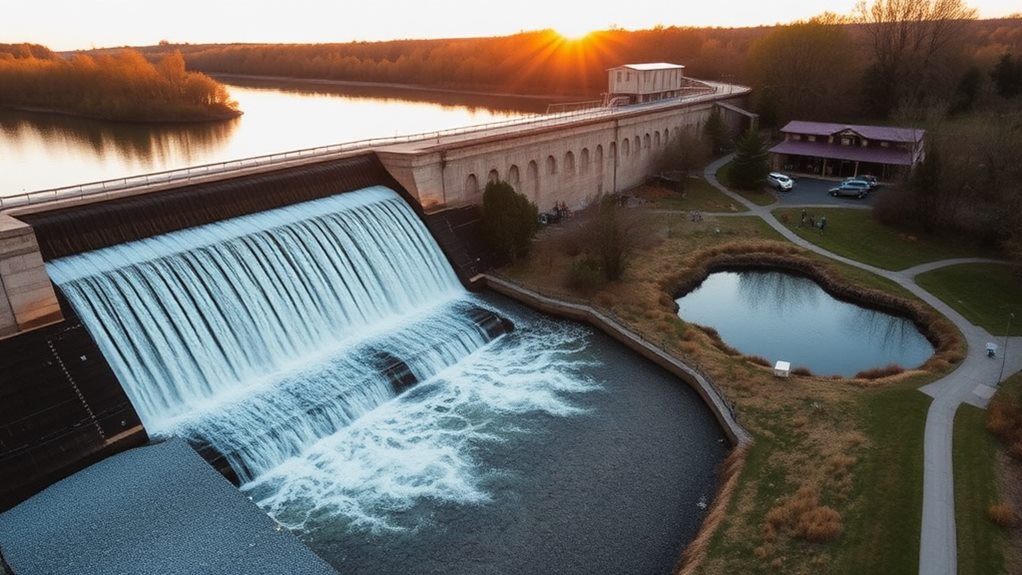
Finding suitable access points below power dams can make or break your fishing success. While access can be limited in many areas, you'll find some reliable spots if you know where to look. Good Times Marina serves as a primary access point for boaters, offering a convenient launch site for those looking to fish the downstream waters.
You'll need to stay informed about current access regulations, as some historically popular locations have become restricted. For example, areas like Eisenhower Park no longer provide the access they once did.
When exploring fishing spots near discharge gates, you'll find improved access on the right side approaching the dam, where catch rates tend to be higher.
Keep in mind that many shore fishing areas face challenges with overgrown vegetation, particularly around spots like Dubay and Centralia dams.
To navigate these obstacles effectively, you'll want to:
- Check local fishing forums for recent access updates
- Consider alternative entry points when vegetation blocks traditional routes
- Connect with other anglers on social media platforms to share real-time information
- Scout locations during low-water periods for the safest entry points
Current and Seasonal Patterns
A river's ever-changing currents and seasonal shifts create distinct patterns that directly impact fishing success below power dams. You'll notice that current patterns form predictable zones where fish gather, especially in eddies and seams where they can feed efficiently without expending too much energy.
When fishing these areas, understanding saltwater fishing techniques can provide valuable insights for adapting your approach in freshwater environments.
To maximize your catch rates throughout the year, keep these key patterns in mind:
- Spring brings excellent opportunities with crappie runs and catfish spawning, making it prime time for higher catch rates.
- Moderate flow rates between 300-600 ft/sec create ideal conditions by boosting oxygen levels.
- Active turbines draw in baitfish, which attract larger predatory fish to the area.
- Seasonal changes affect both fish location and feeding habits, so adjust your strategy accordingly.
Watch for schools of baitfish like shad, but remember that their abundance can make fish pickier about artificial lures. During peak shad seasons, you might need to work harder for strikes.
When you're planning your fishing trips, pay attention to turbine schedules – they're often the key to finding the sweet spots where fish congregate. The predictable current patterns they create can lead you right to the action.
Frequently Asked Questions
Is It Better to Fish Above or Below a Dam?
You'll find better fishing below a dam where there's more oxygen-rich water and concentrated fish activity. The flowing water creates prime feeding spots, and you'll encounter more active fish than above the dam.
Where Is the Best Part of a River to Fish?
You'll find the best fishing spots near dam discharge areas where oxygen-rich waters attract active fish. Look for eddies and deep holes in the current, especially when turbines are running and creating feeding frenzies.
How to Fish the Bottom of a Dam?
You'll need heavy weights to keep bait down, target eddies near the bottom, and let your bait bounce naturally. Cast upstream, using slip bobbers to control depth while fishing dam turbine areas.
Are Catfish Above or Below Dams?
You'll find catfish primarily below dams, where oxygen-rich waters and slower currents create ideal feeding zones. While they can exist above dams too, the concentrated food sources make below-dam areas more productive for catching them.

